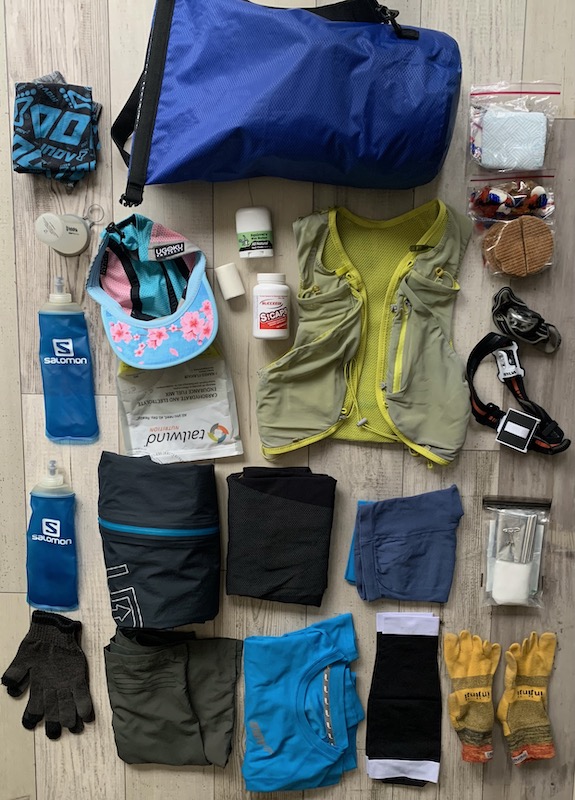
Welcome to part two of the (semi) official Ugoku Projects ultrarunning checklist! This behemoth of a guide will walk you through what I, Ugoku Projects founder and CDO (Chief Daddy Officer) Darryl, have learnt running some quite frankly stupid distances!
The difference between a good race and a bad one can often be as simple as your kit. Here are my race day essentials!

Hydration / running pack
Arguably your most important bit of kit, as it will carry everything you need to stay happy out on the trails.
Your usual long run clothes
Just like you shouldn’t eat anything new on race day, you shouldn’t wear anything new either! That lovely new race day tee you have never tried that rides and feels like a floor sander? Give it a miss.
Appropriate running shoes for the terrain
No use in turning up to a fell race in Vaporflys, or a road ultra in Speedcrosses. Pick a shoe that matches the terrain – but make sure you’ve run plenty of miles in it, and preferably at least three or four long runs.
Emergency toilet kit
Otherwise known as a ‘sh*t kit’, a small ziplock with toilet paper and wet wipes will save you a world of heartbreak should you need to dart off into the bushes. It happens.
GPX route map
Some event companies are better than others at marking their routes. It’s always best to have run a couple of recces in advance, but that’s not always practical. Having a GPX file for the route on your watch or your phone (or both) is super handy.
If you have been running for a while and not seen any markings, a quick glance to your watch can provide reassurance that you are on the right track, rather than earning a couple of extra fun miles around the countryside. It’s like a comfort blanket for ultra running.
Race nutrition
Again, don’t try any new foods on race day – stick with what you learned in training. Make sure you have enough water storage capacity to get you between aid stations, especially on unusually hot days.
A good friend of mine was more prepared than me and showed me a great trick of having a third soft flask stashed in his vest that was purely for spraying on the back of his neck and face. This has an awesome cooling effect and he definitely saved my bacon when I was overheating and out of water with 7 miles to the next checkpoint.
Sunglasses, sun cream, and cap
You can put on sunscreen at the start of a race and have sweated it all off six miles in, only to get roasted along the South Downs with no shade in sight. Hypothetically.
If you’re in the market for a good running cap, I know a guy…

Mandatory kit
Mandatory kit is different from race to race but this is the general requirement for most events. These items are mandatory for a reason, and they are not just for you, as you might come across someone in need on the trail.
Primary and backup head lamps (min 75 lumens)
If anybody running your event faces even the possibility of running in dark or twilight, everyone at the event should be carrying a headlamp (minimum 75 lumens) and a backup (minimum 25 lumens). The backup is more important than you’d think – a friend of mine had to unexpectedly rely on his to get him through the last lap at Wendover Woods 50. Without it, he’d not have been able to finish the entire Centurion Grand Slam!
Survival blanket 1.4m x 2m(some ask for bivi bag)
If you’re looking to go on more adventures outside of running, this is an essential (and cheap) piece of kit that could save your life. Hopefully you never have to use it.
Fully charged mobile phone (with event medic & director contact number)
If you’re likely to be snapping a lot of race day selfies, bring a battery pack!
Waterproof jacket
There’s a lot of choice out there, but make sure whatever you buy has taped seams and is rated waterproof to 10,000mm. It’s possible to spend a small fortune on waterproofs, but unless you’re running the Bob Graham you probably wouldn’t need to. Just remember that this piece of kit can make a massive difference to your race, so if you can afford to spend that bit extra, it could be a good idea.
Whistle
Shouting for help will quickly ruin your voice – a whistle lasts all day!
Long sleeve base layer / fleece
As with waterproofs, these can get expensive, but mostly the savings are in weight. Consider buying a waterproof stuff sack or just a ziplock bag to store your fleece in and keep it dry in case you need it.
Soft cup
Most races are cupless now, which is much better for the environment. A soft cup folds away in your pack and only weighs a few grams.
First aid kit
At minimum, your first aid kit should contain a sterile dressing and bandage.
Water bottles / bladder capable of carrying min. 1 litre
As above, consider carrying an extra bottle on hot days!
Warm hat and gloves (winter races)
Worth taking on any race that isn’t peak summer, as even mild conditions can feel cold if you’re tired or not moving that fast. When packing for any race, always ask yourself – ‘Could I stay warm for 20 minutes if I had to stand still?’ If the answer is no, you haven’t packed enough layers.

The trail and ultra running world is a truly special place, and I’ve made so many wonderful friends through our mutual sufferfests. I certainly hope to be able to do this for as long as physically possible, and having the right kit is a key part of that!
Happy running!